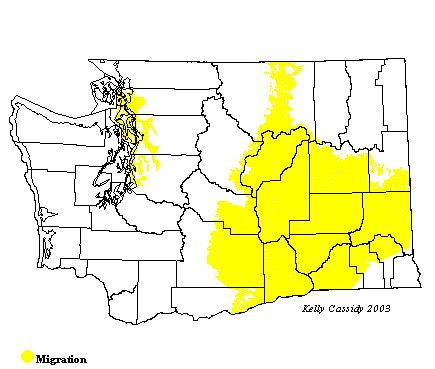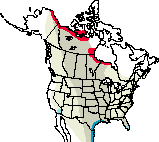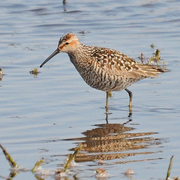Stilt Sandpiper
General Description
Often described as looking like a yellowlegs and feeding like a dowitcher, the Stilt Sandpiper is a medium-sized, long-legged wader. Its breeding plumage is distinctive, but rarely seen in Washington. It is heavily barred brown-and-white above and below, with a white eye-line that separates a rufous cap and cheek. In non-breeding plumage, the Stilt Sandpiper is pale gray, with a light, unstreaked belly and white eye-line. Juveniles are light brownish-gray with lightly streaked breasts and scaled backs. In flight, they show gray and white underwings, solid gray upperwings, white rumps, and gray tails.
Habitat
Stilt Sandpipers' breeding grounds are in the Arctic tundra, north of the tree line. They nest in wet sedge-meadows with raised ridges and hummocks. During the non-breeding season, they are usually found in fresh water ponds, marshes, lagoons, and flooded fields.
Behavior
Large flocks of Stilt Sandpipers are common in areas where they are abundant, but in Washington, single birds or a few birds are generally seen mixed with flocks of dowitchers or Lesser Yellowlegs. Stilt Sandpipers usually forage in shallow water up to their bellies. They probe in the mud for food, often moving their heads up and down, sometimes under water, in a sewing-machine motion like that of a dowitcher. They also pick food from the surface of the water.
Diet
Stilt Sandpipers eat a wide variety of insects and insect larvae during the breeding season. At other times of the year, they eat seeds, leaves, and roots of aquatic plants, marine worms, and other aquatic invertebrates.
Nesting
Stilt Sandpipers generally don't breed until they are two years old. Males arrive on the breeding grounds a few days before females. Pairs form once the females arrive. The male makes a few scrapes in a dry spot on the ground, often on a ridge or hummock of sedge, surrounded by water. The female then chooses one of the scrapes for the nest. The nest may be sparsely lined with sedge leaves. Both parents incubate the four eggs for 19 to 21 days. The young leave the nest within a day of hatching and find their own food. Both parents tend the young at first, but the female usually leaves within seven days. The male stays with the young for 10 to 14 days, but abandons the young before they can fly well, at 17 to 18 days. Each pair raises only one brood per season.
Migration Status
These long-distance travelers migrate through the Great Plains on both their northward and southward routes. They winter as far south as northern South America, although a few can be found wintering in the southern United States. During the fall migration, when juveniles follow about a month behind adults, the migration route is spread out, and some birds stray as far as the West Coast.
Conservation Status
The Canadian Wildlife Service estimates the population of Stilt Sandpipers at 200,000 birds. Populations in some areas have declined, while others have increased. The range-wide status of the population is unknown. This species has a limited and disconnected breeding range, and degradation of some of that habitat is of conservation concern. Changes in land use on South American wintering grounds are also of concern, because some winter gathering spots are being developed. Stilt Sandpipers are listed on the Partners in Flight watch list because of their narrow breeding and wintering distributions, relatively small population, and unknown trends in population.
When and Where to Find in Washington
Stilt Sandpipers are rare in Puget Sound and coastal Washington from mid-June through September, with occasional sightings before and after. In eastern Washington, they are rarely reported from early July through September, with scattered later sightings.
 Abundance
Abundance
| Ecoregion | Jan | Feb | Mar | Apr | May | Jun | Jul | Aug | Sep | Oct | Nov | Dec |
|---|---|---|---|---|---|---|---|---|---|---|---|---|
| Oceanic | ||||||||||||
| Pacific Northwest Coast | R | R | ||||||||||
| Puget Trough | R | R | ||||||||||
| North Cascades | ||||||||||||
| West Cascades | ||||||||||||
| East Cascades | ||||||||||||
| Okanogan | ||||||||||||
| Canadian Rockies | ||||||||||||
| Blue Mountains | ||||||||||||
| Columbia Plateau | R | R | R |
Washington Range Map

North American Range Map


Family Members
 Spotted SandpiperActitis macularius
Spotted SandpiperActitis macularius Solitary SandpiperTringa solitaria
Solitary SandpiperTringa solitaria Gray-tailed TattlerTringa brevipes
Gray-tailed TattlerTringa brevipes Wandering TattlerTringa incana
Wandering TattlerTringa incana Greater YellowlegsTringa melanoleuca
Greater YellowlegsTringa melanoleuca WilletTringa semipalmata
WilletTringa semipalmata Lesser YellowlegsTringa flavipes
Lesser YellowlegsTringa flavipes Upland SandpiperBartramia longicauda
Upland SandpiperBartramia longicauda Little CurlewNumenius minutus
Little CurlewNumenius minutus WhimbrelNumenius phaeopus
WhimbrelNumenius phaeopus Bristle-thighed CurlewNumenius tahitiensis
Bristle-thighed CurlewNumenius tahitiensis Long-billed CurlewNumenius americanus
Long-billed CurlewNumenius americanus Hudsonian GodwitLimosa haemastica
Hudsonian GodwitLimosa haemastica Bar-tailed GodwitLimosa lapponica
Bar-tailed GodwitLimosa lapponica Marbled GodwitLimosa fedoa
Marbled GodwitLimosa fedoa Ruddy TurnstoneArenaria interpres
Ruddy TurnstoneArenaria interpres Black TurnstoneArenaria melanocephala
Black TurnstoneArenaria melanocephala SurfbirdAphriza virgata
SurfbirdAphriza virgata Great KnotCalidris tenuirostris
Great KnotCalidris tenuirostris Red KnotCalidris canutus
Red KnotCalidris canutus SanderlingCalidris alba
SanderlingCalidris alba Semipalmated SandpiperCalidris pusilla
Semipalmated SandpiperCalidris pusilla Western SandpiperCalidris mauri
Western SandpiperCalidris mauri Red-necked StintCalidris ruficollis
Red-necked StintCalidris ruficollis Little StintCalidris minuta
Little StintCalidris minuta Temminck's StintCalidris temminckii
Temminck's StintCalidris temminckii Least SandpiperCalidris minutilla
Least SandpiperCalidris minutilla White-rumped SandpiperCalidris fuscicollis
White-rumped SandpiperCalidris fuscicollis Baird's SandpiperCalidris bairdii
Baird's SandpiperCalidris bairdii Pectoral SandpiperCalidris melanotos
Pectoral SandpiperCalidris melanotos Sharp-tailed SandpiperCalidris acuminata
Sharp-tailed SandpiperCalidris acuminata Rock SandpiperCalidris ptilocnemis
Rock SandpiperCalidris ptilocnemis DunlinCalidris alpina
DunlinCalidris alpina Curlew SandpiperCalidris ferruginea
Curlew SandpiperCalidris ferruginea Stilt SandpiperCalidris himantopus
Stilt SandpiperCalidris himantopus Buff-breasted SandpiperTryngites subruficollis
Buff-breasted SandpiperTryngites subruficollis RuffPhilomachus pugnax
RuffPhilomachus pugnax Short-billed DowitcherLimnodromus griseus
Short-billed DowitcherLimnodromus griseus Long-billed DowitcherLimnodromus scolopaceus
Long-billed DowitcherLimnodromus scolopaceus Jack SnipeLymnocryptes minimus
Jack SnipeLymnocryptes minimus Wilson's SnipeGallinago delicata
Wilson's SnipeGallinago delicata Wilson's PhalaropePhalaropus tricolor
Wilson's PhalaropePhalaropus tricolor Red-necked PhalaropePhalaropus lobatus
Red-necked PhalaropePhalaropus lobatus Red PhalaropePhalaropus fulicarius
Red PhalaropePhalaropus fulicarius

